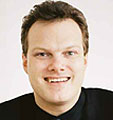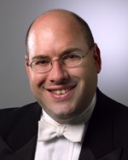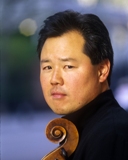- The Linton Chamber Music Series. Six concerts per season at First Unitarian Church in Avondale,
most featuring guest artists with the Cincinnati Symphony Orchestra as an extension to their CSO visits. First Unitarian Church, Cincinnati, Ohio
First Unitarian Church, Cincinnati, Ohio
- “Encore! Linton,” repeats of Linton concerts, usually two, performed at Congregation Beth Adam in Loveland.
- “The Mayor’s 801 Plum Concerts,” a kind of “Linton laboratory” with diverse programming targeted at 20-40 year olds, held Friday evenings twice a year in Cincinnati City Council chambers.
- “Linton Peanut Butter and Jam Sessions.” Educational, interactive programs for kids 2-6 held several times a year in various locations.
It was the final concert of Linton's flagship series in the cozy sanctuary of First Unitarian Church, which on this sunny afternoon felt even warmer with sunlight filtering through the church's stained glass windows.

Pianist Lars Vogt
|

Violinist Alexander Kerr
|

Violist Michael Strauss
|

Cellist Eric Kim
|
The four reminded listeners of Linton's motto, "Music Making Among Friends," since Kerr is former concertmaster of the CSO, which he left in 1996 to become concertmaster of the Royal Concertgebouw Orchestra in Amsterdam. Kerr, who is a friend of Vogt's from Europe, returned to the U.S. last year to become an endowed professor of violin at Indiana University's Jacobs School of Music. Strauss is principal violist of the Indianapolis Symphony (where Kerr occasionally sits in as concertmaster). Kim, CSO principal cellist, is one of Kerr's Cincinnati colleagues.
(Linton artistic director Richard Waller, founder and networking genius of the series, introduced the artists with a bit of banter about current CSO members "coaching" the group at rehearsal.)
Opener was the first movement of Schubert's youthful, unfinished Trio for Violin, Viola and Cello in B-flat Major, D.471. The three players sang in this genial, melodic Allegro. The players' melting tone colors brought Graeter's ice cream to mind and ensemble dove-tailing was superb.
Kerr and Vogt took over for Czech composer Leos Janacek's Sonata for Violin and Piano. Composed between 1913 and 1922, it is a fascinating piece reflective of those turbulent years. Kerr dug into the folk-like Con moto, a very melodic but also pungent movement with an almost flippant character, where Kerr gave his listeners full exposure to his warm, svelte tone. (This reviewer remembers Kerr bowling over Cincinnati city council with his performance of the theme from "Schindler's List" at a council meeting in the 90s.)
The Ballada movement was soft-breathed and endearing; the Allegretto that followed, vigorous and playful, with muscular playing by Vogt and Kerr. The quirky Adagio finale, where the violin "interrupts" the piano repeatedly with sharp, muted gestures and also shares in its melodic outpouring, was full of character, ending with a soft, abbreviated echo of the opening dialectic.
The brief intermission (Vogt flew back to Europe immediately after the concert) was followed by Brahms' youthful Piano Quartet in G Minor, Op.25. Here was a performance to relish -- for beauty of sound, unity of expression and pure zest. Strauss' rich, chocolatey tone, allied with precision and flair, made one wish to hear him more often -- and in the spotlight -- while Kim reminded the crowd how lucky Cincinnati is to have him.
Vogt put considerable oomph into the quartet's opening movement, revealing a forcefully demonstrative complement to the patrician classicism of his Mozart with the CSO. The almost furtive opening of the Intermezzo gave way to a jolly, accelerated Trio before returning whence it came. The players flaunted the lush opening melody of the Andante, then set out what is, in effect, a march in place (it's in 3/4 time) giving it a mighty restatement with Vogt's emphatic lead. They ended the movement on a sentimental note, yielding Brahms' melodic outpouring to an ornamented, gentler, slightly tapered repeat.
Chamber music fans wait for the "Rondo alla Zingarese," Brahms' "Gypsy Rondo" finale. (Symphonic audiences do, too, via Schoenberg's transcription for orchestra.) Brahms' twentysomething effusion got a rousing, spirited performance to match. Swagger, technical brilliance and ravishing melodic departures all played their part for an overwhelming effect. Vogt played like a demon (lightning quick scales) and rosin flew from the strings in the breathtaking Presto conclusion.
Waller announced partial programming for Linton Chamber Music's 08-09, 30th anniversary season, opening in October 5 and 6 at First Unitarian Church and Congregation Beth Adam. respectively, with Canadian pianist Jon Kimura Parker, violist Aloysia Friedmann, Kim and violinist Benny Kim in more Brahms (the Piano Quartet in A Major). Former CSO principal oboist Lian Wang, now New York Philharmonic principal, and CSO concertmaster Timothy Lees and friends will hold forth in Mozart, Vivaldi and Dvorak Nov. 2 and 3. Siblings Gil and Orli Shaham (violin and piano) will be joined by Montreal Symphony principal hornist John Zirbel in Brahms' Trio in E-flat Major, Op. 40, December 14. And on March 8, 2009, the series will feature pianist Yefim Bronfman, program to be announced. Parker and Bronfman are CSO guest artists next season. Additional concerts will be announced later.
Information at (513) 381-6868 or visit www.LintonMusic.org.